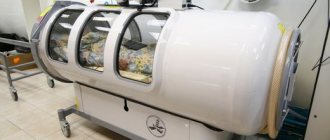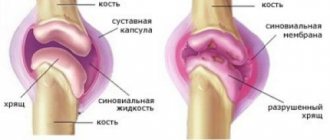| Hirschsprung's disease | |
| Histopathology of Hirschsprung's disease | |
| ICD-10 | 43.143.1 |
| ICD-9 | 751.3751.3 |
| OMIM | 142623 |
| DiseasesDB | 5901 |
| MedlinePlus | 001140 |
| eMedicine | med/1016 |
| MeSH | D006627 |
Hirschsprung's disease
(synonyms:
aganglionosis
,
HSCR
) is a developmental anomaly of the large intestine of congenital etiology, leading to disruption of the innervation of a fragment of the intestine (congenital aganglionosis) - manifested by persistent constipation. In newborns, the clinical picture is unique and varied - it is associated with the extent and height of the location (relative to the anus) of the zone of aganglionosis. The longer the zone of aganglionosis and the higher it is located, the more acute and vivid the symptoms of the disease appear. The disease was first described in 1888 by the Danish pediatrician Harald Hirschsprung in two boys who died of chronic constipation[1].
Etiology and pathogenesis
The basis of the disease is a violation of the innervation of the colon and its lower parts, leading to a decrease (even to the absence) of peristalsis of the aganglionic segment. As a result, intestinal contents accumulate in the overlying sections - constipation occurs.
The genotype-phenotype relationship in HSCR is complex. HSCR occurs as a separate disease in 70% of patients, in 12% it is associated with chromosomal abnormalities, and in 18% of cases it is one of the signs of various hereditary syndromes. By 2014, 10 genes and 5 genetic loci involved in the development of HSCR were discovered[2].
| Type | OMIM | Gene | Locus |
| HSCR1 | 142623 | RET | 10q11.2 |
| HSCR2 | 600155 | EDNRB | 13q22 |
| HSCR3 | 600837 | GDNF | 5p13.1-p12 |
| HSCR4 | 131242 | EDN3 | 20q13.2-q13.3 |
| HSCR5 | 600156 | ? | 21q22 |
| HSCR6 | 606874 | ? | 3p21 |
| HSCR7 | 606875 | ? | 19q12 |
| HSCR8 | 608462 | ? | 16q23 |
| HSCR9 | 611644 | ? | 4q31-32 |
| — | 602229 | SOX10 | 22q13 |
| — | 600423 | ECE1 | 1p36.1 |
| — | 602018 | NRTN | 19p13.3 |
| — | 602595 | SIP1 | 14q13-q21 |
| — | 191315 | NTRK1 | 1q23.1 |
| — | 605802 | ZEB2 | 2q22.3 |
Symptoms
The severity of clinical symptoms varies, depending on the severity (degree of intestinal damage). Symptoms in children with more severe intestinal damage will appear in the first days of life. In less serious cases, they may be noticed later.
In newborns, Hirschsprung's disease may manifest as follows:
- In the first days of life, the child does not pass original feces
- Swollen belly, gas
- Diarrhea
- Vomiting, sometimes with green or brown fluid
Inability to empty the stomach during the first 48 hours of life is often the main sign of Hirschsprung's disease in a newborn.
Hirschsprung's disease in children (photo 2)
Less severe intestinal lesions may not be noticeable for many years, even into adolescence. In these cases, the symptoms are often not pronounced, but long-lasting or chronic:
- enlarged belly
- constipation
- difficulty gaining weight
- vomit
- gas formation
Children may also experience delays in growth and development associated with impaired absorption and the development of malabsorption syndrome due to Hirschsprung's disease.
Early symptoms
- Constipation. This is the first symptom in a child that parents pay attention to. Stool retention begins during the neonatal period. The child passes his first stool late and becomes bloated. Spontaneous passage of feces is extremely rare. Laxatives and cleansing enemas are used to empty the intestines. After enemas, large quantities of dense stool are released.
- Fecal intoxication. With prolonged retention of stool, fecal intoxication develops, more often in childhood. It is characterized by a decrease in body weight and the absence of weight gain in the child, the skin acquires a gray tint, the protein content in the blood decreases, which entails swelling. Violation of water and electrolyte balance affects the functioning of the heart, lungs, liver and other organs.
- Abdominal enlargement. An increase in the size of the abdomen occurs as a result of the accumulation of gases in the intestines, stretching the walls of the intestinal loops with fecal stones. If left untreated, the anterior wall of the abdomen becomes thin, and stretched loops of intestine are visible through it. During the examination, hard fecal stones are clearly palpable.
- Bloating (flatulence). Constipation and impaired mucus formation lead to the development of fermentation and putrefactive processes in the intestinal lumen, which are accompanied by the formation of a large amount of gases and toxic products.
- Stomach ache. They have a bursting, aching character, and can be replaced by cramping pain. Emptying the bowel leads to a short-term subsidence of the pain process. The appearance of pain is associated with overstretching of the intestinal wall above the site of aganglionosis, damage to the mucous membrane by fecal stones and the development of inflammatory processes.
Late symptoms
- Anemia. With Hirschsprung's disease, digestive processes are disrupted and dysbacteriosis develops. These conditions reduce the absorption of vitamins and microelements, and iron deficiency and B12 deficiency anemia develops.
- Hypotrophy. A decrease in body weight can be caused by fecal intoxication, dysbacteriosis and the addition of inflammatory processes. There is an insufficient supply of nutrients from the intestinal lumen into the bloodstream.
- Diarrhea. The appearance of loose stools is due to the development of dysbiosis and inflammatory processes in the intestines.
- Fecal stones. The lack of contractile activity of smooth muscle cells leads to the accumulation of feces, which puts pressure on the intestinal walls, stretches it and creates the risk of developing intestinal obstruction. It is manifested by a lack of stool, bloating, and mucus discharge from the rectum. The child cries and refuses to breastfeed.
- Chest deformity. An enlarged abdomen puts pressure on the diaphragm and mediastinal organs, leading to deformation of the chest. The functioning of the cardiovascular system is disrupted, and bronchopulmonary complications develop.
- Dyspeptic phenomena. A person is worried about nausea, a feeling of heaviness in the stomach, and loss of appetite. There may be heartburn. Vomiting occurs in young children.
The clinical picture greatly depends on the location and degree of intestinal innervation. Hirschsprung's disease in infants manifests itself in the form of the following symptoms:
- lack of original feces (meconium);
- pronounced gas formation;
- flatulence;
- vomiting, sometimes bile;
- prolonged constipation;
- change in the shape of the abdomen;
- inverted or low-lying navel;
- rarely – diarrhea.
Hirschsprung's disease in older children is accompanied by additional symptoms:
- inability to have a bowel movement without an enema;
- abdominal pain;
- intoxication of the body;
- retardation in physical development;
- partial heterochromia;
- the presence of hardened feces (“intestinal stones”);
- anemia;
- chest deformation;
- malnutrition;
- enterocolitis;
- expansion of the colon;
- tendency to develop bronchitis and pneumonia;
- vomiting and diarrhea after prolonged constipation.
Classification of forms and stages of Hirschsprung's disease
- A. Anatomical forms 1. Rectal (25% of cases) a) with damage to the perineal part of the rectum (with a super-short segment)
- b) with damage to the ampullary and supramullary parts of the rectum (with a short segment)
- a) with damage to the distal third of the sigmoid colon
- a) with one segment in the rectosigmoid junction or sigmoid colon
- a) with damage to the left half of the colon
- 1. Compensated
Causes of the disease
Nowadays, the causes of Hirschsprung's disease are completely unknown; doctors only know that it is diagnosed in babies in the first week of life, which means that the formation of the disease occurs in the womb, so hereditary predisposition and gene mutation cannot be ruled out.
The pathogenesis of the disorder is that during pregnancy, when nerve clusters begin to develop, which in the future will be responsible for the digestive system, for unknown reasons a malfunction occurs and the formation process is interrupted. This leads to the absence of nerve endings in a certain area of the intestine.
In the medical field, this pathology is also called aganglionosis. This anomaly can affect either a small area of the intestine or cover the entire organ. Possible reasons include the presence of mental disorders in the parents or disruption of the endocrine system.
Stages of clinical course
| Compensated | Subcompensated | Decompensated |
| Newborns have constipation, which worsens when switching to artificial feeding. With good care, enemas, the general condition is not impaired | Option for transition from compensated to decompensated stage. Slow progression of symptoms, siphon enemas are increasingly used. With adequate therapy, transition to the compensated stage | Progression of symptoms |
| 1st degree - stable compensation | 1 degree trend towards improvement | 1st degree (acute) - usually immediately after birth: low intestinal obstruction (meconium and gases do not pass, flatulence, visible intestinal peristalsis, profuse vomiting) |
| 2nd degree - loss of appetite, fecal blockages at the slightest violation of the regime | Grade 2 - tendency to worsen | 2nd degree (chronic) - recurrent enema field obstruction |
| Characteristic early symptoms of the disease | Characteristic early and late symptoms | Characteristic early and late symptoms |
| Usually with rectal aganglionosis | More often with rectosigmoidal subtotal and total forms of aganglionosis | More often with rectosigmoidal subtotal and total forms of aganglionosis |
What is it, classification
There are several forms of such pathology as Hirschsprung's disease (in children). The symptoms that appear in a child may indicate the type of illness.
The following forms of Hirschsprung's disease are distinguished:
- Compensated – constipation occurs at an early age. They are dealt with using cleansing enemas for a long time.
- Subcompensated - enemas do not have a relieving effect. As a result of the deterioration of the condition, weight loss occurs. The patient feels heaviness and pain in the abdomen. With this form of the disease, the appearance of shortness of breath and anemia is observed. Metabolism undergoes noticeable changes.
- Decompensated - the intestines cannot be cleansed with cleansing enemas and laxatives. After these measures, the feeling of heaviness in the lower abdomen and bloating do not stop. If you change your diet or undergo intense physical activity, severe intestinal obstruction may develop. In child patients, this form of the disease is diagnosed with subtotal and complete lesions.
- Acute – intestinal obstruction in newborns.
Hirschsprung's disease is a disease in which certain segments of the intestine become dilated, affecting the large intestine, which leads to difficulty in defecation. The aganglionic zone determines the presence of the degree of the disease; it can occupy several centimeters or fill the entire intestinal area.
There are five forms of the disease.
- Rectal. A small area of the rectum is typically affected. This form responds well to therapy and is diagnosed in children over five years of age. The condition is characterized by rare constipation.
- Rectosigmoidal. The rectum and sigmoid colon are affected (partially). Characterized by long-term persistent constipation, accumulation of feces, and severe pain. This disease manages to manifest itself already in the first months of a baby’s life, especially in artificially born children.
- Segmental. It is extremely rare. Characteristically, small areas of the sigmoid colon are affected, alternating with healthy areas of the intestine. Both intermittent constipation and a complete absence of any bowel movements may be observed. There is severe bloating, a “frog” belly.
- Subtotal. It is also a rare form, but at the same time quite severe. The left or right side of the colon is affected. In almost all cases, surgery is required. Manifested by delayed physical or mental development.
- Total. The small intestine (partially) and the entire large intestine are affected. It is the rarest variant of Hirschsprung's disease. The child shows signs of obstruction from birth.
In addition to the forms of the disease, the degrees of the disease are also considered, there are four of them:
- compensated - there are no symptoms of anemia and developmental delay, constipation;
- subcompensated - deterioration of general condition as a result of prolonged constipation; an enema does not help to cope with the problem;
- decompensated - with the slightest deviation from the diet, prolonged constipation occurs that cannot be treated with medication, and intestinal obstruction develops;
- acute - occurs in the absence of dietary nutrition.
Because the disease develops, there are three stages:
- early - there is a slight increase in the size of the abdomen, chronic constipation, flatulence;
- late – additional symptoms join the existing ones: numbness, protein deficiency, chest deformation, stones form from feces;
- complicated - severe pain, paradoxical vomiting, and a high risk of developing intestinal obstruction are added to the previous symptoms.
Literature
- Lenyushkin A.I.
Pediatric coloproctology. Guide for doctors, M., Medicine, 1990—352 p. - Hertl M.
Differential diagnosis in pediatrics in 2 vols. Trans. with him. M., Medicine, 1990. - Poddubny I.V., Isaev A.A., Alieva E.I., Kozlov M.Yu., Nakovkina O.N., Loban N.V.
First experience of laparoscopic endorectal reduction of the colon in Hirschsprung's disease in children. Pediatric surgery - 2006 - 3 - pp. 7-8. - Hirschsprung's disease. (English)
Diagnostics
From the medical arsenal, instrumental and functional research methods are used to diagnose the disease.
If Hirschsprung's disease is suspected in adults, the doctor prescribes a biopsy. Ultrasound of the intestines becomes mandatory. Anorectal manometry is performed.
The use of X-rays with a contrast agent will help identify features of intestinal motility:
- An abdominal x-ray will help identify areas of colon enlargement. The absence of feces above the anus is stated.
- After using the enema, irrigoscopy with a contrast agent is performed. The method will detect narrow and wide areas. Data is provided on the condition of the intestinal walls.
- Anorectal manometry is performed to measure pressure in the large intestine and internal sphincter.
- A colonoscopy will help identify areas where nerve impulses do not travel due to the absence of nerve cells. A biopsy for histological examination will show an abnormality.
Differential diagnosis includes studies of the intestine and meconium plug, stenosis of the terminal ileum. The dynamics of intestinal patency is recorded.
Operations can be carried out according to several schemes. The most common procedures are the Swensen-Bill rectosigmoidectomy, the Duhamel rectal approach (Duhamel procedure), the Soave endorectal procedure, and the deep anterior colorectal anastomosis according to Rehbein.
Notes
- Hirschsprung, H. (1888). "Stuhlträgheit Neugeborener in Folge von Dilatation und Hypertrophie des Colons". Jahrbuch für Kinderheilkunde und physische Erziehung 27
: 1–7. - ↑ 1234
Hirschsprung's disease (HSCR) // Center for Molecular Genetics of the Medical Genetic Research Center - Suita S, Taguchi T, Ieiri S, Nakatsuji T (2005). "Hirschsprung's disease in Japan: analysis of 3852 patients based on a nationwide survey in 30 years." Journal of Pediatric Surgery 40
(1): 197–201; discussion 201–2. DOI:10.1016/j.jpedsurg.2004.09.052. PMID 15868585. - ↑ 1 2
Goldberg E.L. (1984).
"An epidemiological study of Hirschsprung's disease". Int J Epidemiol 13
(4):479–85. DOI:10.1093/ije/13.4.479. PMID 6240474. - Colwell, Janice.
Fecal and Urinary Diversion Management. - Mosby, 2004. - P. 264. - ISBN 978-0-323-02248-4. - Goldman, Lee.
Goldman's Cecil Medicine. — 24th. - Philadelphia: Elsevier Saunders. - P. 867. - ISBN 1437727883. - Order of the Ministry of Health and Social Development of the Russian Federation No. 73 of February 9, 2006 “On approval of the standard of medical care for patients with Hirschsprung’s disease” // gastroscan.ru
- Order of the Ministry of Health and Social Development of the Russian Federation No. 362 of May 29, 2007 “On approval of the standard of medical care for patients with Hirschsprung’s disease (when providing specialized care)” // gastroscan.ru
Treatment of the disease
The main treatment for Hirschsprung's disease is surgery. It is based on the elimination of that part of the intestine that has undergone deformation and that area of the organ where there are no nerve endings. Then reconstruction surgery is performed. It consists of stitching a healthy intestine with the rectum.
After this method of therapy, all symptoms that caused discomfort disappear. But this method is indicated only for older patients. For newborns and small children, preliminary treatment methods are carried out. Only after they are completed, the operation is performed. Such therapy includes:
- performing enemas with a medicinal solution;
- taking medications that improve intestinal microflora;
- a special diet based on the consumption of foods enriched with fiber, including fermented milk products, buckwheat and corn porridge, and vegetables. In addition, the child needs to be given more than two liters of fluid per day;
- injections of drugs containing protein;
- abdominal massage.
Only after such procedures are performed, children are prescribed surgical intervention.
In order to avoid complications after surgery, it is necessary to adhere to proper and balanced nutrition. Avoid fatty, spicy and salty foods and consume more vitamins and nutrients found in fruits and vegetables. After normalization of the condition, it is best to introduce the child to sports.
What to do?
If you think you have Hirschsprung's disease
and the symptoms characteristic of this disease, then doctors can help you: pediatrician, gastroenterologist, proctologist.
Source
Did you like the article? Share with friends on social networks:










